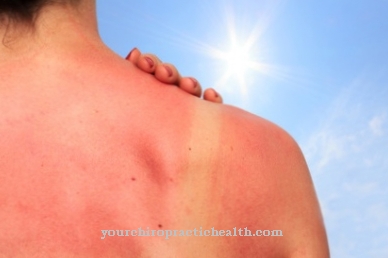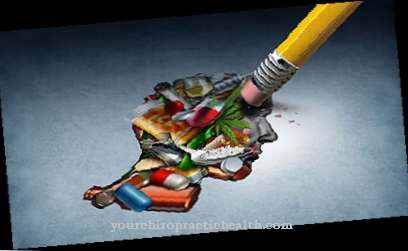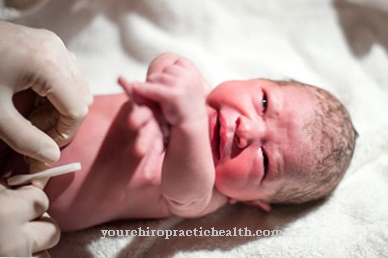The Hypertensive crisis or the hypertensive emergency is a sudden increase in blood pressure to levels greater than 200/130 mmHg. The disease must be treated immediately, otherwise it can turn into a life-threatening hypertensive emergency.
What is a hypertensive crisis?
.jpg)
© suphaporn - stock.adobe.com
As Hypertensive crisis is a term used to describe a suddenly high blood pressure. A distinction is made between a hypertensive crisis and a hypertensive emergency. Both have blood pressure values higher than 200 mmHg systolic and / or 130 mmHg diastolic.
While a hypertensive crisis is not life-threatening as it does not cause organ damage, a hypertensive emergency is a complication. The high blood pressure can damage organs, cerebral haemorrhage, a stroke or a heart attack.
The hypertensive crisis always carries the risk of developing into a hypertensive emergency. The sudden increase in blood pressure is one of the most common internal medical emergencies; about a quarter of these patients have a hypertensive crisis or emergency. Women are affected much less often than men.
causes
As causes for a Hypertensive crisis different circumstances come into consideration. Often high blood pressure (primary hypertension) already exists, but it is not treated as directed by the doctor.
The patients do not carry out the therapy consistently, drugs are not taken regularly, alcohol is consumed in excess despite the high blood pressure, drugs, especially stimulating amphetamines, are consumed or the diet remains too fat and rich.
Stress with pre-existing high blood pressure can also trigger a hypertensive crisis. Another cause in women can be high blood pressure during pregnancy; the hypertensive crisis is referred to here as eclampsia. Kidney diseases and hormonal disorders also lead to increased blood pressure, which can derail into a hypertensive crisis.
Symptoms, ailments & signs
A hypertensive crisis can cause a whole range of symptoms and complaints, which can appear in different types and degrees. Headache, shortness of breath and chest pain are typical of the disease. This is usually accompanied by nausea and vomiting, nosebleeds or dizziness. The increased blood pressure can also cause neurological disorders such as perception disorders or symptoms of paralysis.
If the hypertensive crisis is not treated promptly, the high blood pressure can cause irreversible damage to the organs. Outwardly, the disease manifests itself in a severely reddened head, sweats and protruding veins on the neck and arms. Many sufferers also shiver or suffer from twitching, which increases in intensity as the disease progresses and is sometimes associated with pain.
A hypertensive crisis can cause a heart attack or circulatory collapse. A heart attack initially manifests itself as a rapid increase in chest pain, accompanied by numbness in the right arm and difficulty swallowing. Circulatory collapse can occur quickly in a hypertensive crisis - initially there are slight disturbances of consciousness, which quickly develop into dizziness and brief moments of unconsciousness. If immediate treatment is not given, the patient becomes unconscious and there is an acute risk of death.
Diagnosis & course
The symptoms of hypertensive crisis can occur in different forms. Older people who have had high blood pressure for a long time can often tolerate the sudden rise in blood pressure better than young people who normally have low blood pressure.
They usually have the stronger symptoms. Typical complaints are headache, shortness of breath, chest pain, nausea, nosebleed, vomiting or visual disturbances. Some people have neurological disorders such as numbness or impaired perception. Confused states also occur.
For the emergency doctor, it is initially not important whether there is a hypertensive crisis or a hypertensive emergency. If extremely high blood pressure is measured, it must be reduced slowly and immediately in both cases. In the further course he receives additional information by asking about the symptoms and the medical history.
Other examinations such as blood and urine examinations, EKG (measuring the heart rate), x-ray of the lungs, computed tomography (CT) of the head, neurological examinations and the reflection of the fundus are among the usual methods for suspected hypertensive crisis.
Complications
This crisis can lead to a life-threatening condition for the patient, so that immediate treatment is necessary. In the worst case, the person affected can die from the symptoms of this crisis. The sharp rise in blood pressure usually leads to headaches and a very red head. Those affected continue to suffer from vomiting and severe nausea.
The patient's resilience also drops enormously and normal activities can no longer be carried out without further ado. Those affected suffer from paralysis and numbness that can spread throughout the body and may continue to lose consciousness. It is not uncommon for chest pain to occur, which can lead to a heart attack.
It is not uncommon for patients to suffer from nosebleeds and visual disturbances as well. There is a general adeptness of the patient which reduces the quality of life. Treatment is carried out with the help of drugs and is aimed at lowering blood pressure.
Complications and irreversible damage can then occur if the blood pressure drop happens too quickly. Furthermore, treatment of the underlying disease is necessary in order to prevent this crisis in the future. This may also reduce life expectancy.
When should you go to the doctor?
Immediate action is necessary in the event of sudden high blood pressure. If there is intense internal heat, palpitations, sweats, restlessness and reddening of the skin, an emergency doctor should be called immediately or a hospital visited. If the symptoms cannot be traced back to an immense physical or sporting activity, the person concerned needs help. Since the hypertensive crisis can lead to loss of life without immediate medical care, an ambulance service must be alerted. A feeling of pressure inside the body, tension in muscles and tendons and nervousness are warning signs of the organism. If treatment is not started as soon as possible, life-long consequential damage can occur in addition to death.
Paralysis or failure of individual functions are possible. Most often, a survivor of a hypertensive crisis needs daily care and support in coping with everyday life. Call a doctor if you have a headache, shortness of breath or difficulty breathing. Nausea and sudden vomiting are other signs of a disagreement. The person concerned must be examined as soon as possible in the event of sensitivity disorders, tingling in the limbs or numbness. Persistent stress or periods of emotional challenge can be the cause of the physical problems that exist. A visit to the doctor is therefore recommended as soon as the person concerned has blood pressure problems for a long time.
Doctors & therapists in your area
Treatment & Therapy
A Hypertensive crisis necessarily requires medical attention so that it does not derail into a hypertensive emergency. This represents an acute, life-threatening emergency that must be treated immediately by an emergency doctor.
In the event of an emergency, therapy begins on the spot and is continued during the transport to the clinic. The blood pressure must be reduced immediately, but only slowly. The reduction in pressure in the event of a hypertensive emergency must be monitored by intensive care medicine so that it does not happen too quickly. A too rapid drop in blood pressure could not process the organs and especially the brain, it would lead to bleeding and irreversible damage.
In the case of a hypertensive crisis, it is also necessary to lower the blood pressure slowly. However, this treatment can also take place at home with medication in tablet form, while in a hypertensive emergency the antihypertensive substances must be administered by infusion. In addition, the patients are given drugs that promote water excretion (diuretics). Finally, once blood pressure has normalized, any underlying disease must be treated to prevent a reoccurrence of a hypertensive crisis.
Outlook & forecast
The prognosis of a hypertensive crisis or a hypertensive emergency depends on the speed with which the patient receives adequate medical care. The sooner intensive care is possible, the better the chances of a good prognosis. A full recovery is possible under optimal conditions. In many cases, a few minutes can determine the further development of the patient's health.
If medical care is provided too late or not at all, the risk of the patient's premature death increases significantly. Alternatively, permanent functional disorders of various systems in the organism can be expected, which lead to a strong impairment of the general quality of life. Only rarely can a later alleviation of the existing symptoms be documented in the emergency situation without medical help.
The reason for this is that the administration of medication lowers blood pressure within a short period of time. If it does not happen, the blood pressure continues to rise and the blood vessels burst. The medication is necessary to stabilize the patient. In addition, a controlled lowering of the blood pressure is required so that there are no further complications. If this succeeds, another treatment and therapy plan can be drawn up. This usually provides for the elimination of the trigger of the hypertensive crisis or the necessary change in current living conditions.
prevention
Since a Hypertensive crisis Usually occurs when you already have high blood pressure, you can prevent it by consistently treating the high blood pressure, paying attention to a healthy diet, avoiding stress and getting enough exercise. Regular monitoring of blood pressure is also helpful, especially in the case of existing underlying diseases that cause the symptom of high blood pressure.
Aftercare
After a hypertensive crisis it is important to check the blood pressure values regularly. In the event of a hypertensive emergency, follow-up care must be followed closely (at least 1x / 30min). In order to prevent a further derailment of the blood pressure and the associated stress on the cardiovascular system, an underlying hypertension should be treated permanently with the help of drug therapy.
The choice of medication and the desired values depend on the age and concomitant diseases of the person affected. The aim of therapy is a continuous reduction in blood pressure. A survey of existing risk factors should also be carried out in order to minimize the risk of a renewed derailment of blood pressure. Non-drug measures can be found in compliance with a special nutrition plan. A healthy, low-salt diet (a maximum of six grams of table salt per day) is desirable.
Plenty of fruit, vegetables and a simultaneous reduction in certain foods (for example, saturated fatty acids, which are increasingly found in foods of animal origin). Substances that have a negative effect on the cardiovascular system should also be avoided. It is advisable to generally avoid alcohol, coffee and nicotine. In obese patients, normalization of body weight must be aimed for. Regular endurance sports are also recommended.
You can do that yourself
The hypertensive emergency, but also the hypertensive crisis, is a potentially life-threatening emergency. This must always be treated by a specialist. In the acute situation, those affected can primarily ensure that they remain calm. You can try relaxation exercises to have a positive influence on the high blood pressure.
After the acute phase, the main focus is on prophylactic measures that can minimize the risk of another crisis. Regular and correct intake of the prescribed antihypertensive medication is particularly important. Only a reliable intake enables a permanent lowering of the blood pressure.
In the long term, those affected should strive for a change in their lifestyle. This includes weight loss, preferably through a Mediterranean diet with lots of white fish, vegetables and olive oil. It is also advisable to keep the salt content in food low. Smoking, alcohol and excessive caffeine consumption should be avoided entirely. Regular exercise and light endurance sports for at least 30 minutes, three to five days a week, can also reduce high blood pressure and thus the risk of a hypertensive crisis. Excessive stress is a possible trigger for a blood pressure crisis, so it is important to avoid stress in everyday life and at work whenever possible.

























.jpg)


